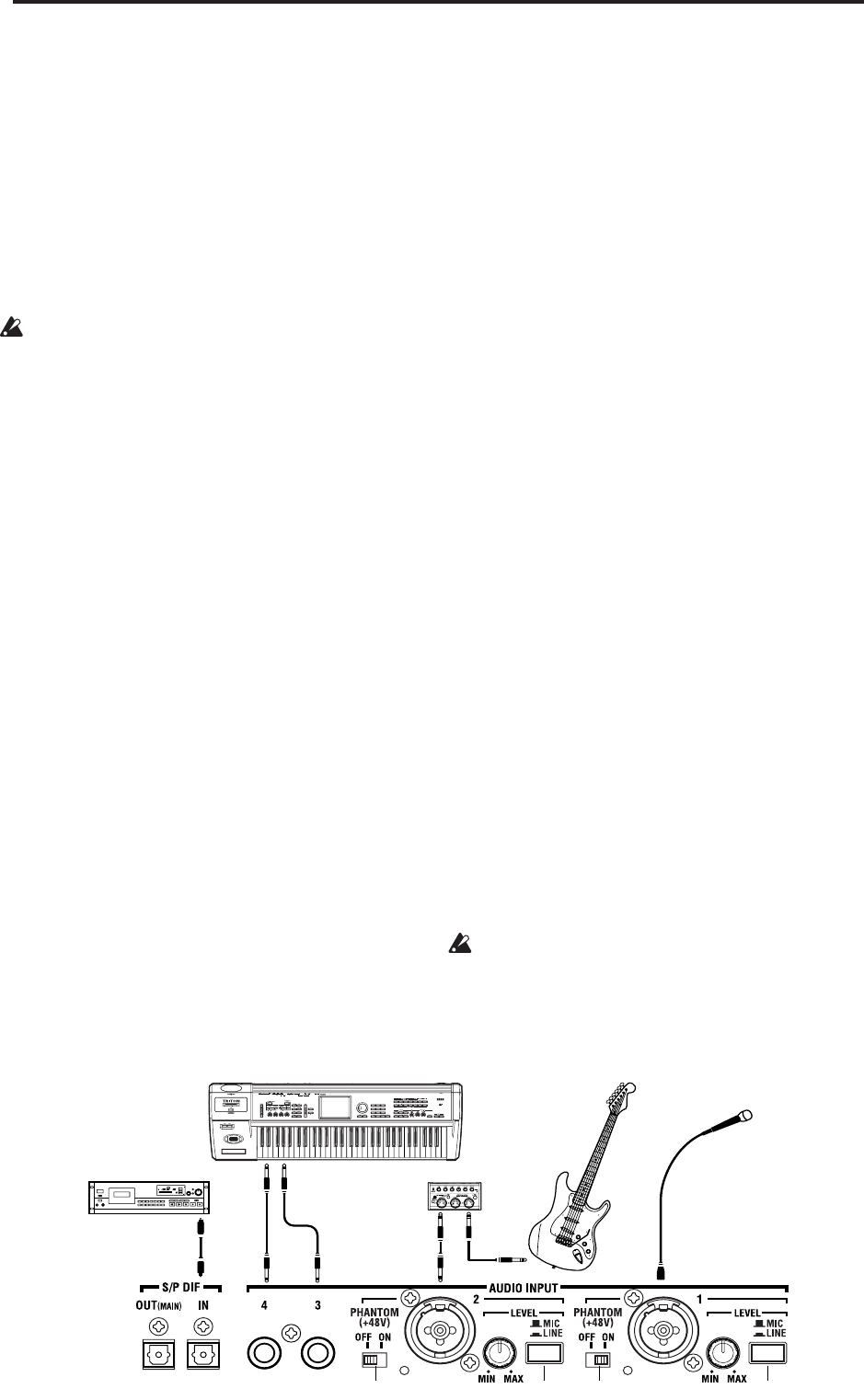
Sampling (Open Sampling System)
122
1…8: The external audio input signal will be sent to
INDIVIDUAL 1, 2, 3, 4, 5, 6, 7, or 8 in monaural.
1/2…7/8: The external audio input signal will be sent
via the Pan setting to INDIVIDUAL 1 and 2, 3 and 4, 5
and 6, or 7 and 8 in stereo. Set Source Bus to the
corresponding Indiv. input.
Off: The external audio signal will not be sent to a bus.
In Sampling mode, if you want to sample an external
audio signal directly without routing it through a bus,
go to the P0: Recording– Audio Input page, and choose
the external input you want to sample (Audio Input 1–
4, S/P DIF L, S/P DIF R) as the “Source Bus.”
Please note than when you change Bus Select
(IFX/Indiv.) from Off to L/R or IFX, the volume
level to the AUDIO OUT L/MONO and R jacks or
to the headphones may dramatically increase.
FX Ctrl Bus (FX Control Bus)
The FX Control Buses lets you create effects
“sidechains.” Sidechains let you control an effect with
one audio signal (the sidechain), while the effect
processes a completely different audio signal. This is
convenient for use with vocoders, compressors and
limiters, gates, etc.
OASYS includes two true- stereo FX Control Buses. For
more information, see “FX Control Buses” on page 730
of the Parameter Guide.
REC Bus
This sends the external audio input signal to the REC
buses (four mono channels; 1, 2, 3, 4).
The REC buses are dedicated internal buses used for
sampling or for recording audio tracks in Sequencer
mode.
If you want to sample these buses, set Source Bus to a
REC bus.
In Sampling mode, you can mix several audio inputs to
a REC bus for sampling, or you can mix the direct
sound of audio inputs with the sound processed by
insert effects and sample the combined result from the
REC bus.
In other modes (e.g., Program mode), you can use the
REC buses to sample just an audio input that’s playing
along with a KARMA performance being output to the
L/R bus.
Off: The external audio signal will not be sent to the
REC buses. Normally you will use the Off setting.
1, 2, 3, 4: The external audio input signal will be sent to
the specified REC bus. The Pan setting is ignored, and
the signal is sent in monaural.
1/2, 3/4: The external audio input signal will be sent in
stereo to the specified pair of REC buses. The Pan
setting sends the signal in stereo to buses 1 and 2 or
buses 3 and 4.
Send1 (to MFX1), Send2 (to MFX2)
These adjust the levels at which the external audio
input signal is sent to the master effects.
Send1 (to MFX1): Send the signal to master effect 1.
Send2 (to MFX2): Send the signal to master effect 2.
If Bus Select (IFX/Indiv.) is set to IFX1–12, the send
levels to the master effects are set by the post-IFX1–12
Send1 and Send2.
PLAY/MUTE
This indicates whether the external audio signal being
input is in PLAY or MUTE status.
You can use the MIX PLAY/MUTE 1–6 switches to
change this.
SOLO On/Off
This indicates the SOLO status of each external audio
signal input. You can use the MIX SELECT 1–6
switches to change this.
Sound will be output only from channels for which
SOLO is On. Other channels will be muted. The solo
function includes the oscillators of the tone generator.
Pan
This specifies the panning of the external audio input
signal. When inputting a stereo audio source, you will
normally set the inputs to L000 and R127 respectively.
Level
Specifies the level of the external audio signal that will
be input. Normally you will set this at 127.
The analog audio signals from the AUDIO INPUT
1–4 jacks are converted by a AD converter from
analog to digital signals. This parameter sets the
level of the signal immediately after it has been
converted into digital form. If the sound is distorted
LINE ONOFF MIC
Condenser
mic
Guitar
Effect unit
Synthesizer
DAT, etc.


















